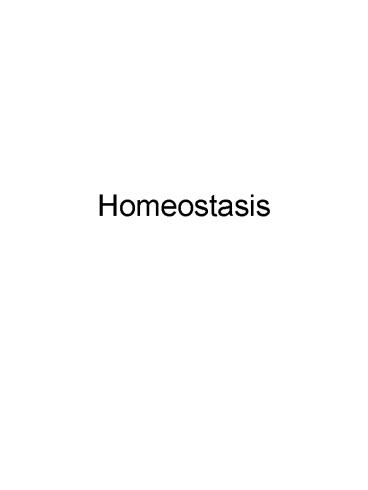Homeostasis PowerPoint PPT Presentation
Title: Homeostasis
1
Homeostasis
2
Homeostasis
- Definition the maintenance of equilibrium in
bodily processes. - Example the maintenance of the volume of bodily
fluid and the specific composition of the
different bodily fluids.
3
Components of Feedback Systems
- Receptorssensory receptors, chemical receptors,
oxygen receptors, etc. - Control centerevaluates input and regulates
output of nerve impulses or release of chemical
signals. - Effectora body structure that receives output
from the control center and produces a response.
4
Negative Feedback System
- Receptorsbaroreceptors in the blood vessels
sense change in blood pressure. - Control centerevaluates input from baroreceptors
and releases chemical signals. - Effectorsthe heart receives chemical signals and
adjusts blood pressure.
5
Positive Feedback System
- Receptorsstretch sensitive nerves in cervix send
signals to the brain. - Control centerthe brain evaluates the signal and
releases oxytocin. - Effectorsthe muscles in the uterine wall
contract more forcefully, which increases signals
to the brain.
6
Bones role in calcium homeostasis
- The importance of calcium
- Proper functioning of muscle and nerve tissue
- Blood clotting
- Cofactor in many enzymatic reactions
- Blood levels of calcium need to be maintained at
around 9-11mg/100mL. - Ca2 levels too high can lead to cardiac arrest.
- Ca2 levels too low may halt respiration.
7
Homeostasis
stimulus
Stimulus decreases calcium
Controlled condition
Calcium gt 9mg/100mL andlt 11 mg/ML
Disrupted condition
Calcium lt 9mg/100mL
Parathythroid gland cells detect lowered Ca2
PTH gene turned on
Osteoclast activity increases and kidneys retain
Ca2 and produce calcitriol
Response altering condition
Ca2 gt 9mg/100mL
8
Homeostasis Hypercalcemia
stimulus
Controlled condition
Disrupted condition
Response altering condition
9
Homeostasis Osteoporosis I
stimulus
Controlled condition
Disrupted condition
Response altering condition
10
Homeostasis Osteoporosis II
stimulus
Controlled condition
Disrupted condition
Response altering condition
11
Homeostasis Rickets
stimulus
Controlled condition
Disrupted condition
Response altering condition
PowerShow.com is a leading presentation sharing website. It has millions of presentations already uploaded and available with 1,000s more being uploaded by its users every day. Whatever your area of interest, here you’ll be able to find and view presentations you’ll love and possibly download. And, best of all, it is completely free and easy to use.
You might even have a presentation you’d like to share with others. If so, just upload it to PowerShow.com. We’ll convert it to an HTML5 slideshow that includes all the media types you’ve already added: audio, video, music, pictures, animations and transition effects. Then you can share it with your target audience as well as PowerShow.com’s millions of monthly visitors. And, again, it’s all free.
About the Developers
PowerShow.com is brought to you by CrystalGraphics, the award-winning developer and market-leading publisher of rich-media enhancement products for presentations. Our product offerings include millions of PowerPoint templates, diagrams, animated 3D characters and more.

